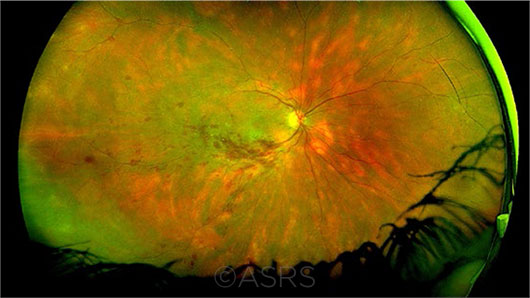Download PDF
An intravitreal insert that slowly releases fluocinolone acetonide (FAi) to control inflammation associated with chronic, noninfectious posterior uveitis has been approved by the FDA. The novel drug delivery system was developed to break the treatment-quiescence-recurrence-treatment cycle that is a hallmark of the disease.
“For the first time, we’ll have an injectable delivery system that can be implanted in the clinic and can release the drug for up to three years,” said Glenn J. Jaffe, MD, at Duke University in Durham, North Carolina. Moreover, the implant will deliver “consistent dosing without the peaks and valleys [seen with] local corticosteroids,” he said. Dr. Jaffe is lead author of a report on the 12-month safety and efficacy results of a phase 3 FAi clinical trial.1
 |
BIRDSHOT. This ultra-widefield image is of a 45-year-old patient with central retinal vein occlusion and birdshot chorioretinopathy (HLA-A29+). This image was originally published in the ASRS Retina Image Bank. Mark E. Kleinman, MD, and Deborah McDonald. CRVO on Birdshot. Retina Image Bank. 2017; Image Number 27314. © The American Society of Retina Specialists.
|
A step forward. FAi, which will be brought to market under the brand name Yutiq (EyePoint Pharmaceuticals), builds on the strengths of earlier implants. Ozurdex (Allergan), an injectable insert containing 0.7 mgdexamethasone, lasts about three months, whereas Yutiq lasts up to three years. Retisert (Bausch + Lomb) is a long-lasting fluocinolone acetonide implant, but it requires surgical implantation, whereas Yutiq can be implanted via an in-office procedure.
Study specifics. Dr. Jaffe and his colleagues enrolled 129 people with recurrent noninfectious posterior uveitis. Subjects were randomly assigned to FAi (n = 87) or sham injection (n = 42). In the FAi group, 0.18 mg of the drug was delivered via the implant, which was injected through the pars plana into the vitreous cavity of the study eyes using a 25-gauge needle.
Recurrences. At 12 months, the FAi recurrence rate was significantly lower than that observed in the sham cohort (28% vs. 91%, respectively). The median time to first recurrence was 378 days in FAi eyes, compared to 70.5 days for sham eyes.
Recurrences were treated as needed. Through 12 months, 19% of the FAi group and 40% of the sham cohort had at least one adjunctive systemic treatment. Topical corticosteroid treatment was prescribed to 21% of FAi eyes and to 48% of sham eyes.
These findings confirmed what Dr. Jaffe had observed in 11 patients in an earlier study.2 “What we saw was that the eyes remained quiet over a two-year period without recurrences. I was frequently able to get patients off systemic medications and drops without additional injections,” he said.
Additional findings. Fewer FAi eyes lost 15 or more letters in best-corrected visual acuity (VA) than did sham eyes (14% vs. 31%, respectively). In addition, VA was preserved or improved more often with FAi.
With regard to intraocular pressure (IOP), FAi eyes were more likely to experience pressures greater or equal to 25 mm Hg or 30 mm Hg. More FAi eyes than sham eyes required IOP-lowering medication through 12 months, but the rate of surgical intervention was similar in the two cohorts.
Eyes treated with FAi were at greater risk of developing cataracts than were those in the sham cohort (33% vs. 12%, respectively). Of the 42 FAi eyes that were phakic at baseline, 14 (33%) required cataract surgery after 12 months.
Assessing risks and benefits. Although Dr. Jaffe did not downplay the cataract findings, he noted that cataracts are a known complication of uveitis treatment. “People on steroids for a long enough period of time will eventually develop cataracts. I’d rather not have cataract, but if I can control the inflammation with an implant and keep patients seeing well, it’s a worthwhile trade-off,” he said.
As part of this assessment of risks and benefits, he referred to the implant’s effect on recurrence rates, “which will help prevent secondary complications that can lead to vision loss.”
—Miriam Karmel
___________________________
1 Jaffe GJ et al. Ophthalmology. Published online Oct. 24, 2018.
2 Jaffe GJ et al. Ophthalmology. 2016;123(9):1940-1948.
___________________________
Relevant financial disclosures—Dr. Jaffe: EyePoint Pharmaceuticals: C. This study was funded by EyePoint Pharmaceuticals; the sponsor participated in the design of the study, study conduct, data collection, data management, data analysis and interpretation, and preparation and review of the manuscript.
For full disclosures and the disclosure key, see below.
Full Financial Disclosures
Dr. Jaffe AbbVie: C; Alcon: C; EyePoint Pharmaceuticals: C; Heidelberg Engineering: C; Neurotech USA: C; Novartis: C.
Dr. Jain None.
Dr. Merle Bausch + Lomb: C; Laboratoires Théa: S.
Dr. Mollan None.
Dr. Pearce None.
Disclosure Category
|
Code
|
Description
|
| Consultant/Advisor |
C |
Consultant fee, paid advisory boards, or fees for attending a meeting. |
| Employee |
E |
Employed by a commercial company. |
| Speakers bureau |
L |
Lecture fees or honoraria, travel fees or reimbursements when speaking at the invitation of a commercial company. |
| Equity owner |
O |
Equity ownership/stock options in publicly or privately traded firms, excluding mutual funds. |
| Patents/Royalty |
P |
Patents and/or royalties for intellectual property. |
| Grant support |
S |
Grant support or other financial support to the investigator from all sources, including research support from government agencies (e.g., NIH), foundations, device manufacturers, and/or pharmaceutical companies. |
|
More from this month’s News in Review